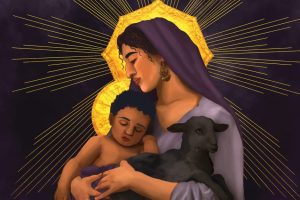“In the beginning was the Word,” wrote St John. “He is the image [ikon in Greek] of the invisible God, the firstborn of all creation,” wrote St. Paul. We meet him still in both word and image.
Both have figured in the worshiping life of followers of Christ from the church’s beginning, as visitors to the catacombs in Rome are reminded. The bones are mainly gone, but icons remain on the walls and ceilings of those underground places where Christians prayed and celebrated the Eucharist.
In the eighth century, when the emperor of Constantinople outlawed icons and initiated a 55-year wave of destruction of sacred images in the East, many iconographers fled to Italy for safety and continued their work under the pope’s protection.
Fashion can destroy even more thoroughly than imperial edicts. Through never banned in the West, icons gradually fell out of favor during the Renaissance. Increasingly religious paintings moved toward natural lighting, the illusion of three dimensions, and the ever more vivid portrayal of emotion—all qualities carefully avoided in iconography, which aims for silence and stillness. Icons are not emotionally manipulative. They are less a display of individual talent than the creation of a zone of prayer using artistic minimalism.
Early in the 20th century a slow recovery of appreciation of icons began. Today icons can be found not only in Orthodox and Catholic churches but also in Protestant churches and homes. It is a form of ecumenism without words or arguments.
Icons may be beautiful, but they do not exist just to add a little color or a special atmosphere to the rooms they happen to be in. They’re there to help us pray. An icon that isn’t being used in prayer is like a musical instrument not being played or a cookbook that never gives birth to a meal.
But just how can you use them in prayer? First of all, identify a place in your home—such as a corner of a room or a fireplace mantel—that provides a place where you can stand for short times slightly apart from the busyness of daily life. This will be your “icon corner.”
At the beginning you probably won’t have any hand-painted icons, but in religious bookstores or online you can easily find good, inexpensive printed icons mounted on wood.
You might start with an icon of the face of Christ. These are usually called Pantocrator icons, from the Greek word for “Lord of Creation.” They show not only his face but the book containing the gospels resting against his heart. If the book is open, it will often show one of the “I am” texts—such as “I am the truth, the way, and the life.” Such icons remind us that God became incarnate, revealing himself not only to our ancestors but to us, and that each person—no matter how well he or she has managed to hide it—is made in God’s image. Finally such icons remind us that one day we will be present for the Last Judgment and will hear Christ say, “What you have done to the least person, you did to me.”
You may also want an icon of Mary holding Christ in her arms. In many of these their faces are touching. These “tenderness icons” vividly remind us that love is at the core of life, and that to follow Christ and to revere his mother inevitable draws us toward the source of love and mercy. Mary’s body language always draws us toward her son, as if she were saying, “Do whatever he tells us.”
Arrange your icon corner so that a candle or vigil lamp can be lit during the periods when you’re praying. Icons are best suited to places that aren’t brightly lit and seem to flourish in candlelight.
So there you are in your icon corner. But how are you praying? You may be praying in silence, simply remembering the crucial fact that God is at the center of everything, that it is impossible not to be in God’s presence even if we’re totally oblivious to this reality.
You may be able to talk to God as comfortably as if you were talking to your very best friend. God made us to communicate and much of that communication is in words. Something terrible may have happened and you may just want to stand there and cry—or complain to God.
If you are at all like me, someone who usually feels embarrassed with attempts at devising my own words of prayer, you may want to use some of the prayers that have arisen during the centuries Jews and Christians have been around: the psalms or canticles in the Old and New Testaments (such as the one by the three young men in the furnace in Daniel, or Mary’s Magnificat). In any religious bookstore you will find collections of prayers organized into periods of the day. Little by little you can learn many prayers by heart.
Your icons don’t have to be suitable for a fine art book. It’s the faith of the praying person that matters most—a lesson I learned from Dorothy Day.
In her early 60s at the time, she was having increasing trouble climbing the five flights to her apartment in Manhattan’s Little Italy. We found another not far away and only one flight up, but in appalling condition. A friend and I went down to clean and paint it. We dragged box after box of debris down to the street, including what seemed to us an awful painting of the Holy Family rendered in bright colors against a gray background on a piece of plywood. We shook our heads, deposited it in the trash along the curb, and went back to our labor.
Not long after that, Dorothy arrived, the painting in hand, “Look what I found! The Holy Family! It’s a providential sign, a blessing.” She put it on the mantel of the apartment’s bricked-up fireplace.
Looking at it again, this time I saw it was a work of love.
This article was originally published in the January 2002 issue of U.S. Catholic.
Image: Flickr cc via Randy OHC












Add comment